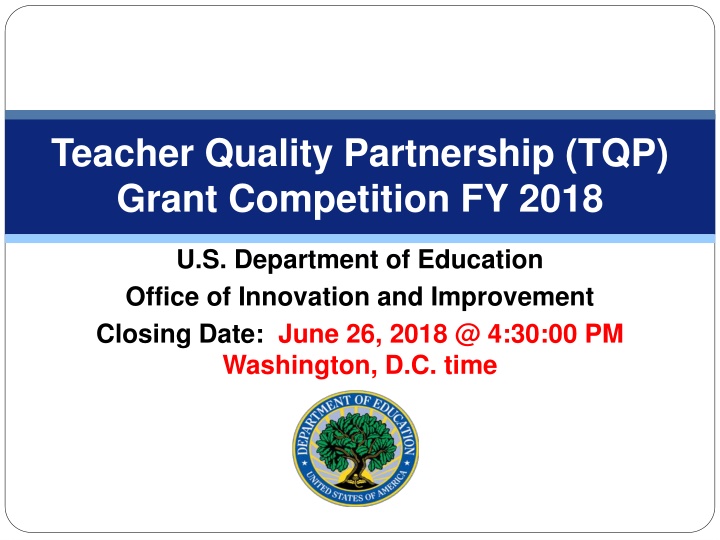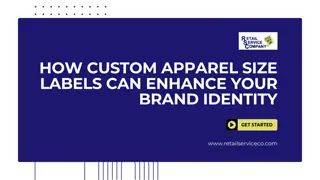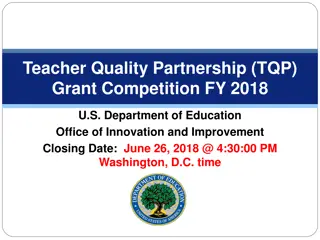
Teacher Quality Partnership (TQP) Grant Competition FY 2018 Details
Learn about the Teacher Quality Partnership (TQP) Grant Competition FY 2018 by the U.S. Department of Education. Discover application details, program priorities, eligibility requirements, and essential resources. Don't miss the closing date and make sure to review the provided guidance thoroughly.
Download Presentation

Please find below an Image/Link to download the presentation.
The content on the website is provided AS IS for your information and personal use only. It may not be sold, licensed, or shared on other websites without obtaining consent from the author. If you encounter any issues during the download, it is possible that the publisher has removed the file from their server.
You are allowed to download the files provided on this website for personal or commercial use, subject to the condition that they are used lawfully. All files are the property of their respective owners.
The content on the website is provided AS IS for your information and personal use only. It may not be sold, licensed, or shared on other websites without obtaining consent from the author.
E N D
Presentation Transcript
Teacher Quality Partnership (TQP) Grant Competition FY 2018 U.S. Department of Education Office of Innovation and Improvement Closing Date: June 26, 2018 @ 4:30:00 PM Washington, D.C. time
Note About These Slides The slides presented on this webinar will be available for download on the TQP webpage. Applicants are strongly encouraged to download the TQP TQP Application Package from the TQP webpage and review it in its entirety. The TQP Application Package provides instructions needed to apply for this TQP grant. http://innovation.ed.gov/what-we-do/teacher-quality/teacher-quality-partnership/ Note: These slides are intended as guidance only and do not impose any requirements beyond those included in the language of 20 U.S.C. 1021 1022h, the NIA, and any other applicable provisions established in rules for this competition. Please refer to the official documents published in the Federal Register. 2
General TQP Competition Q&A Applicants are strongly encouraged to read the TQP Notice Inviting Applicants in its entirety. Applicants are strongly encouraged to read the TQP Frequently Asked Questions (FAQ) document in its entirety as it addresses many questions that applicants may ask. If your questions are not answered in the TQP FAQ document, you may email them to the TQP program inbox at TQPartnership@ed.gov. Please do not wait until the last minute to email your questions. 3
Agenda for This Webinar I. TQP Program Purpose and Overview II. Eligibility Requirements III.TQP Program Requirements IV. FY 18 Program Priorities V. Selection Criteria & Scoring VI. Competition Reminders and Resources 4
FY 18 TQP Program Priorities Promoting Science, Technology, Engineering, or Math (STEM) Education, With a Particular Focus on Computer Science (0-3 points) Partnership Grants for the Preparation of Teachers (Pre-Bac Model) Promoting Effective Instruction in Classroom and Schools (0-3 points) Partnership Grants for the Establishment of Effective Teaching Residency Programs (Residency Model) Novice Applicants (0-2 points) Applicants MUST address ONE Absolute Priority Only Applicants may address any of these Competitive Preference Priorities 5
Absolute Priorities Applicants should read the TQP NIA for full Absolute Priority language. Applicants will address only ONE Absolute Priority by addressing the Selection Criteria. Applications that address both priorities may not be reviewed. Applicants should clearly identify which Absolute Priority they are addressing. Applicants must address ALL Absolute Priority requirements or may be deemed ineligible. Applicants are strongly encouraged to use the Optional Absolute Priority Checklist found on the TQP webpage and in the TQP Application Package. 6
Absolute Priority 1: Pre-Bac Model Highlights Pre-Bac models may include a 5th year licensing program Pre-Bac models must reform ALL or an IDENTIFIED PART of IHE s teacher preparation program Pre-bac model reforms must be completed within the life of the proposed grant period. Pre-Bac models may change/develop program curriculum Pre-Bac models must recruit teacher candidates based on the needs of the partner high-need LEA Pre-Bac models must provide a year-long clinical experience Pre-Bac models must provide a 2-year induction program Pre-Bac models must support and train teacher candidates (See section 202(d) of the HEA for full Absolute Priority 1 language) 7
Absolute Priority 2: Residency Model Highlights Residency models establish/design new teaching residency programs Residency models must have a rigorous selection criteria for residents and mentor teachers Residency models may provide a one-year Living Wage Stipend Residency model graduates must teach for 3-years in the partner high-need LEA Repayment of Living Wage Stipend is required, if service obligation is not met Residency models must provide a 2-year Induction Program Residency models must provide training and support for teaching residents 8
Residency Model Highlights (cont.) Residency models must offer a 18-month Master s degree and teacher certification program NOTE: 18 Month Residency Models: The statute requires that Teaching Residency programs offer all residents a program that would lead to completion of a Master s degree and teacher certification in 18 months. However, this does not mean that each resident necessarily needs to obtain his or her degree in 18 months; rather the program must be designed to permit them to do so in 18 months. Grantees may consider the individual circumstances of each teaching resident, and determine whether to allow more time to complete the degree and/or teacher certification within the project period. 9
Competitive Preference Priorities (CPP) Applicants should read the TQP NIA for full language of the three CPPs. The CPPs are optional; applicants are not required to address these priorities. Applicants should clearly identify if they have addressed any of the three CPPs and where the response can be found in the application. The CPPs are worth up to an additional 8 points. 10
Competitive Preference Priority 1 Promoting Science, Technology, Engineering, or Math (STEM) Education, With a Particular Focus on Computer Science. Projects designed to improve student achievement or other educational outcomes in one or more of the following areas: STEM or computer science. These projects must address the following priority area: Increasing the number of educators adequately prepared to deliver rigorous instruction in STEM fields, including computer science, through: Recruitment; Evidence-based professional development strategies for current STEM educators; or Evidence-based retraining strategies for current educators seeking to transition from other subjects to STEM fields. 11
Competitive Preference Priority 1 Promoting Science, Technology, Engineering, or Math (STEM) Education, With a Particular Focus on Computer Science. How does an applicant demonstrate that its proposed strategy for professional development and retention strategy for current STEM educators is evidence-based? Submitting a citation of a study that is (1) focused on a STEM- focused professional development or retraining strategies, (2) relevant to the proposed project, and meets at least the design standards set forth in the Promising Evidence definition. OR Submitting a Logic Model that (1) identifies the STEM professional development or retraining strategy of the project and (2) is informed by research or evaluation findings that suggest the project component is likely to improve Relevant Outcomes. 12
Competitive Preference Priority 2 Promoting Effective Instruction in Classroom and Schools Projects that are designed to support the recruitment or retention of educators who are effective and increase diversity (including but not limited to, racial and ethnic diversity). 13
Competitive Preference Priority 3 Novice Applicants Projects submitted by applicants that meet the definition of novice applicant at the time of they submit their application. Has never received a grant or sub-grant under the TQP program; Has never been a member of a group application (i.e. in a TQP eligible partnership); and Has not had an active discretionary grant from the Federal Government in the five years before the deadline date for applications under the program. 14
Priority Questions If you have questions about TQP program priorities, please first review the TQP FAQ document on the TQP webpage. If your question is not answered in the FAQ document, you may email your questions to TQPartnership@ed.gov. 15
Thank you for your interest in the TQP Grant Program. Best Wishes on a successful TQP application submission. Closing Date: Tuesday, June 26, 2018 @ 4:30:00 PM Washington, D.C. time



















